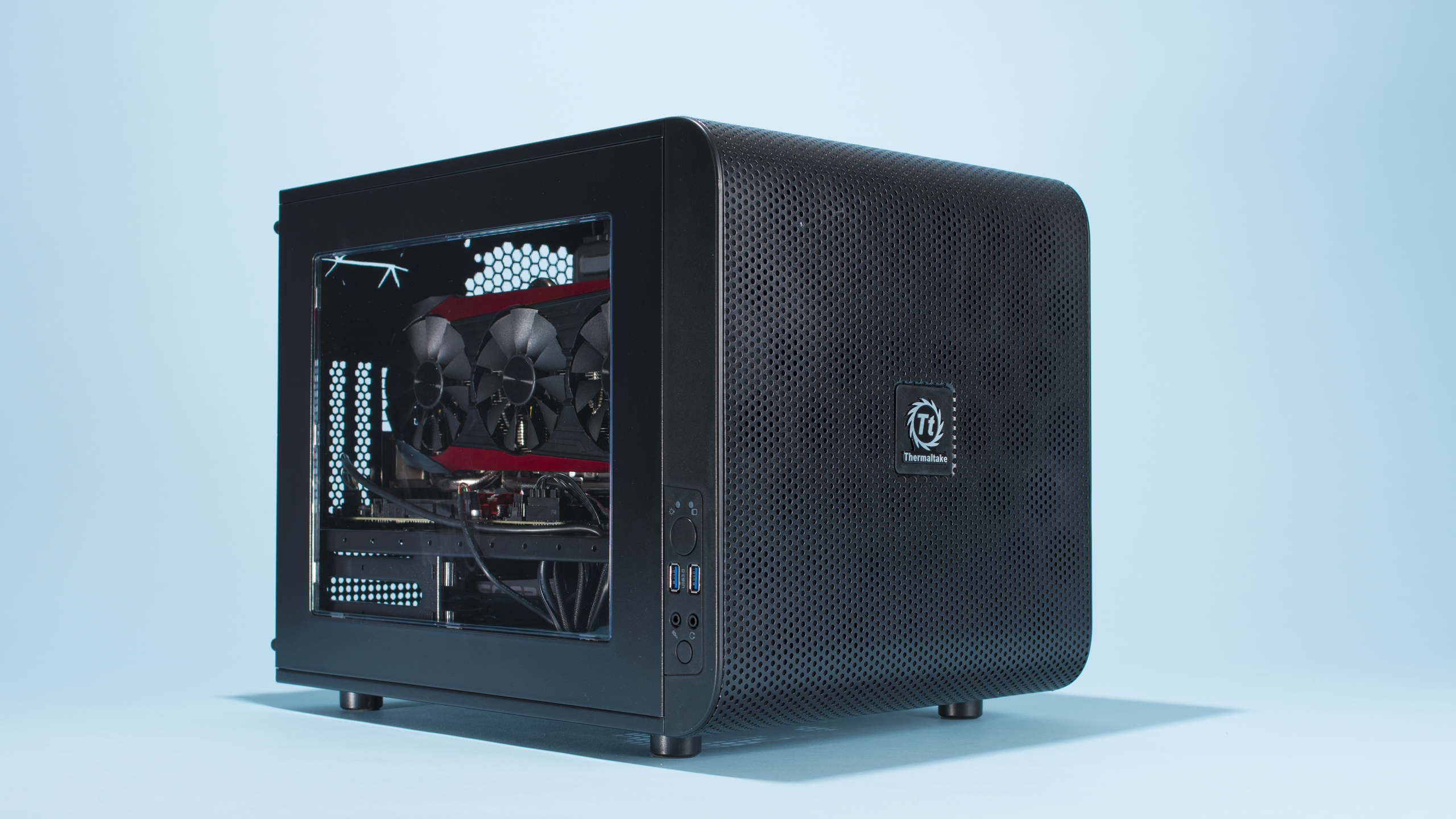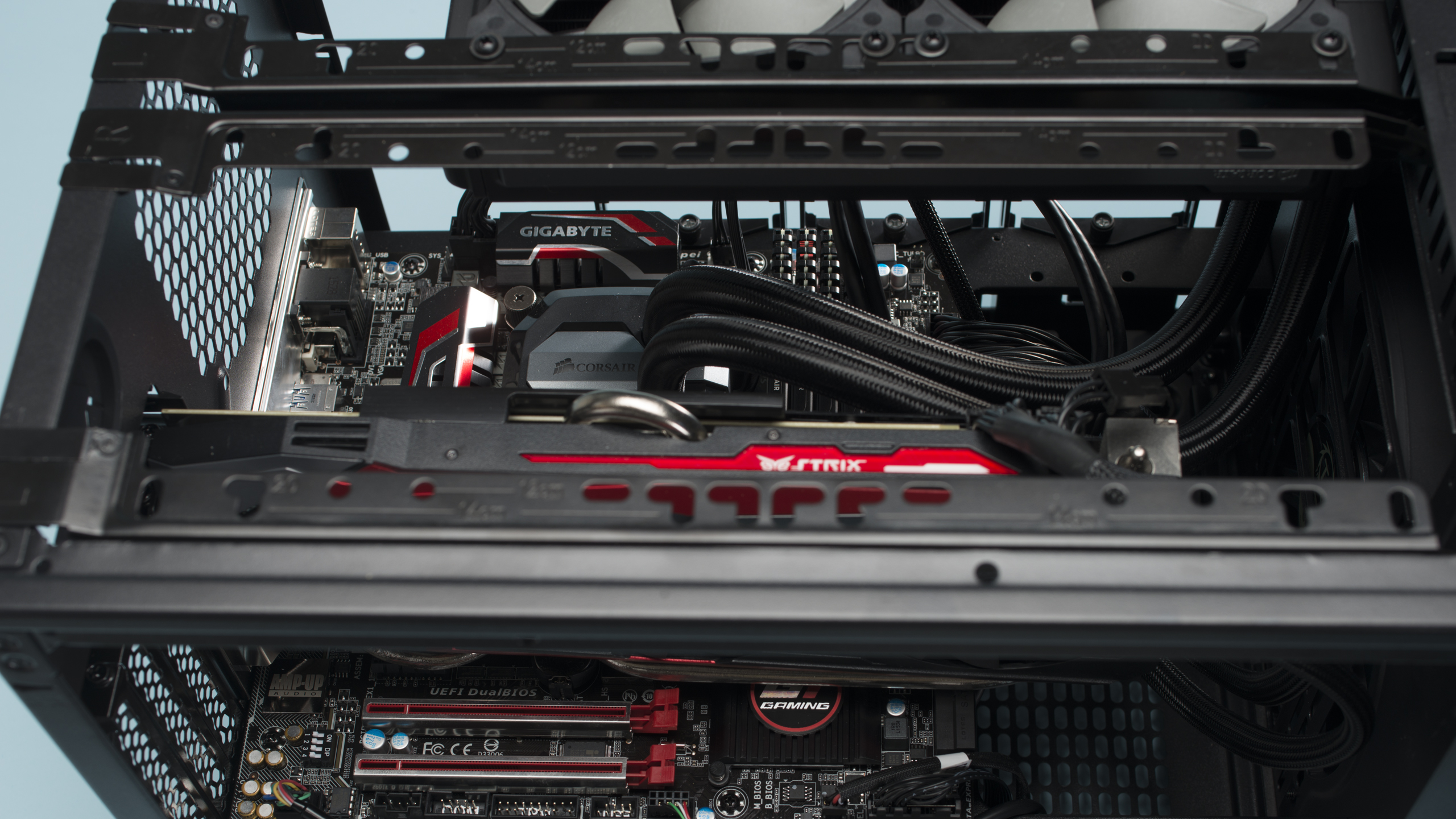The Winter 2016 Midrange Rig

Anything but average
Our Midrange rig gets a lot of flak for its name. "An i7 isn't midrange," people say, "and a $1,500 budget is performance grade!" Yes, fair builder, for many our Midrange build would be considered a performance machine. But when we can build rigs with the X99 chipset, the title of Midrange starts to feel right on point.
With a budget of $1,500, we have a lot of choices open to us with the Midrange. Different priorities can be chosen, but at the end of the day, we're still looking for good frame rates at 1440p. We also look to create an overclocking platform that will allow users to grab a little extra power for their money.
So, what did we come up with this time around? Let's take a look.

| Row 0 - Cell 0 | Component | Price |
| CPU | Intel Core i7-6700K | $413 |
| GPU | Asus R9 390 Strix | $340 |
| Memory | 16GB (4x4GB) Corsair Vengeance LPX DDR4-2666 | $100 |
| Mobo | Gigabyte G1 Gaming GA-Z170MX-Gaming 5 | $150 |
| SSD | 500GB Samsung 850 Evo M.2 SATA | $170 |
| CPU Cooler | Corsair H100i GTX 240mm | $110 |
| PSU | EVGA SuperNOVA G2-0750 750W 80 Plus Gold | $115 |
| Case | Thermaltake Core V21 Micro ATX | $70 |
| Row 9 - Cell 0 | Total | $1,468 |
Big Red
When you're looking for video cards in a build, you have two main camps to choose from: Nvidia (Team Green) or AMD (Team Red). Truth be told, we've fallen on the Green side quite often. Lower power draws and price for performance has favored Nvidia in the last few iterations of graphics cards. Just look at the GTX 980 Ti versus the R9 Fury X, for example. However, the new line of Polaris cards from AMD may change that calculus later this year.
For what's available now though, we wanted to make sure that the Midrange rig was capable at 1440p, while also being comfortably VR-capable.That rules out the likes of the GTX 960. We've gone with the GTX 980 before, but pricing in this round didn't allow for the card in our budget. The GTX 970 felt like too little for this price range. Luckily, AMD's R9 390 happily fills the spot between the two in both price and performance.
At $340, the R9 390 Strix actually is near price parity of the GTX 970. Depending on the models you compare, the 390 can actually cost less than Team Green's 970, making it our recommended card for builders looking for good performance without the price pain of the GTX 980.
In our testing , the 390 held its own when compared to other Midrange rigs that used the 980, with a price tag that's $200 lower. On top of that, it comfortably tops the score of the Oculus Rift recommended spec in 3DMark's Fire Strike as well.
Keep up to date with the most important stories and the best deals, as picked by the PC Gamer team.
Low center of gravity
For PC enthusiasts who have grown to love the tower-style configuration, going with a smaller, box-shaped rig can feel strange. It can be easy to assume bigger is always better, since big, honkin' towers allow for plenty of airflow and room to work. We're here to tell you that smaller, compact cases can keep your CPU and GPU plenty cool.
At first glance, the Thermaltake V21, looks similar to the dimensions of the Fractal Node 804 we used with the Fall 2015 Turbo build. Aside from rough dimensions, the similarities end there. While the Node 804 had a dual-bay setup that mounted the motherboard vertically, the V21 opts for a horizontal tray for the mobo. We like this type of layout for one clear reason: It allows for multiple large video cards to be mounted easily, without worrying about warping the PCI Express connections.

While we opted for going with an M.2 SSD, the 2.5-inch drive mounts are movable and removable. The 3.5-inch drive mounts sit under the motherboard tray, adjacent to the PSU. This leaves plenty of space up top for full-length video cards, which gave our R9 390 plenty of room to breathe.
One of the things that you'll either love or hate about the case is that there's grating on every side of it. The case comes with removable, magnetically-attached mesh that covers the grating to help keep dust under control. That's great for attaching fans wherever you want, but it's tougher to get air to flow from one place to another without a lot of fans. Without solid side panels, there's no channeling of air, so that's one thing to consider. On the plus side, heat can escape though any side of the case.
Bigger isn't always better
We went with micro-ATX for a couple of reasons. First, micro-ATX cases can be more exciting and different than full-ATX cases can be. That holds even more true for mini-ITX, but we wanted this build to offer the opportunity to use Crossfire in an upgrade.

Adding a second video card requires another PCIe slot, so micro-ATX was the only way to go if we wanted to stay clear of full-ATX. We also had to make sure we had enough power for a second card if we wanted it, so we went with a 750W PSU. The 750W that the EVGA PSU can supply would be just barely enough if we wanted to add another R9 390 and give the i7-6700K a conservative overclock. Of course, this build is somewhat light on storage, so if we were to add spinning HDDs to that list, going with an 850W PSU would offer more peace of mind.
The benchmarks
One of the great things about this PC is that it offers performance that beats the GTX 970 for about the same price. That makes the PC Oculus-ready, which is a good goal to shoot for in 2016. The rig beat the Oculus Rift recommended spec score in 3DMark Fire Strike Ultra by a few hundred points, though the test wouldn't verify our score since we use the recent Crimson hotfix drivers.
For reference, the "Build It: Gloriousness" rig used a GTX 970 and an i5-4590, which is pretty much the CPU-GPU combination recommended by the spec. You can see the difference in scores by mousing over the bars below.
While beating the Oculus spec is nice, not everyone is aiming to strap a pair of goggles onto their dome. The real aim of the Midrange rig is to dominate the 1440p battlefield. While the the R9 390 doesn't have the muscle to slap the GTX 980 around, it does have the price to make the buyer think twice. We wouldn't recommend playing games at 4K with this card, since its frame rates dip down into the 30s in Shadow of Mordor and averages just over 31 in Tomb Raider. That could be playable with a FreeSync monitor, but it's a far cry from topping the ideal goal of 60 fps.
While the rig's marks aren't impressive for 4K gaming, things started looking a lot better once we scaled down to 1440p. It's true that 1440p doesn't look or sound as sexy as 4K does, but when it comes down to it, nearly all of the high-end gaming monitors available are built with a native resolution of 2560x1440. If you plan on playing games, the 1440p mark is a safe bet, especially if you are going to use FreeSync (or G-Sync with Nvidia GPUs).
In this realm, the R9 390 did very well, and tied with the Fall and Summer builds from 2015, both of which were powered by GTX 980s. At 87 fps, the Winter 2016 Midrange rig crept up and showed why the R9 390 is a good value compared with the GTX 980.
For the CPU tests, the i7-6700K does quite well. In single-threaded applications, the unlocked Skylake's speed is challenged only by the i7-4790K Devil's Canyon. A base clock speed of 4GHz is the main reason for this, and is why the 6700K makes mincemeat of its younger cousin, the i5-6500 (with a base clock of just 3.2GHz).
In Gigapan Stitch, we can see that multiple cores can be used, but most of the test rests heavily on single-threaded performance. Were this not true, we'd see lower completion times from the Haswell-E chips. It is worthwhile to note that while the Build It: Rocket Science rig has a Haswell-E CPU, it was overclocked in the spirit of following the Dream Machine. (The Build It was in the same print issue as the Dream Machine, October 2015.) While we often use K-SKU CPUs, we usually only test them at stock clocks.
Our next test is ProShow Producer 5. The program reports to use all available threads, and gets eight to play with from the i7-6700K. Hyper-Threading matters, and is one of the big things that sets the i5 series apart from the i7s. If you need more logical cores, the i7 is the only way to go. For this test, the 6700K supplies those cores with gusto.
Finally, we come to the X264 benchmark, which really puts each core to the test, so the PC with the most threads almost always comes out on top. Overclocking can affect the score here, but the number of threads is by far the biggest determinant of success. Note the scores for the Dream Machine and the Zero Point. Both PCs use the i7-5960X and dominate the other rigs, but the Dream Machine pulls ahead by way of overclocking. The overclocked 5930K in the Build It: Rocket Science still falls behind the stock clock of the Zero Point's 5960X. With eight logical cores, the i7-6700K does well, but still falls short of the hexa- and octa-core Haswell-E CPUs.
All in all, the Midrange rig is a beast of a PC for the vast majority of gamers out there. It can hold its own in workstation applications too, but shouldn't be expected to best a Haswell-E just yet.
If we could put more into this PC, we'd spend a little more on storage. Five hundred gigabytes is nice, but it can quickly fill up. With marks like these, however, it's hard to say that spending another $200 to go from the R9 390 to a GTX 980 is a tough sell, but may be preferable for fans of Team Green.


